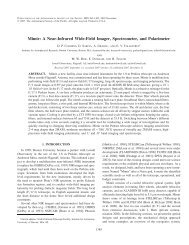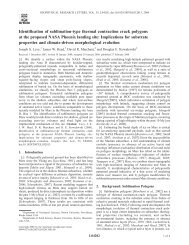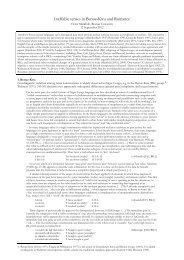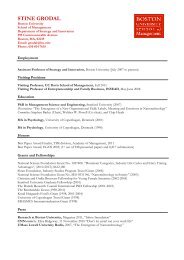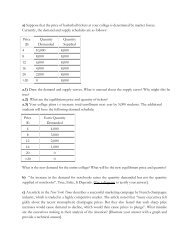Finite-step-ahead acts <strong>and</strong> densenessFinally, we define finite-step-ahead acts <strong>and</strong> show that the union of all the sets of finite-stepaheadacts is dense. LetH +1 = {h +1 ∈ (∆(C × ∆(H))) S : ∀s ∈ S, h +1 (s) ∈ ∆(C × ∆(L))}.Since H ≃ (∆(C ×∆(H))) S , we can embed H +1 into H, where the range of H +1 is embeddedinto L since L ≃ ∆(C × ∆(L)). Inductively, defineH +τ = {h +τ ∈ (∆(C × ∆(H))) S : ∀s ∈ S, h +τ (s) ∈ ∆(C × ∆(H +(τ−1) ))}.Similarly, we can embed H +τ into H. We call ⋃ τ≥1 H +τ the domain of finite-step-ahead acts.Lemma 9 The domain of finite-step-ahead acts ⋃ τ≥1 H +τ⋃τ≥1 ∆(C × ∆(H +τ)) is a dense subset of ∆(C × ∆(H)).is a dense subset of H. Also,This result is analogous to Proposition 1 in Hayashi (2005) <strong>and</strong> its proof is omitted. Itis useful to establish the existence of a risk equivalent as in Lemma 9 of Hayashi (2005). Wehave implicitly applied a similar result in Appendix A.43
C Appendix: Proof of Theorems 4 <strong>and</strong> 5We prove the sufficiency of the axioms. The proof of necessity is routine.C1. Representation of Risk PreferenceWhen {≽ s t} is restricted to the domain C × ∆(L), Axiom B3 (History Independence of RiskPreference) implies that {≽ s t} induces a single preference relation ≽ defined on C × ∆(L).By Axiom B1 (Order) <strong>and</strong> Debreu’s (1954) theorem, there is a continuous representationV : C × ∆(L) → R of ≽ . We fix such a representation.By Axiom B2 (Current Consumption Separability), V (c, ·) <strong>and</strong> V (ĉ, ·) represent the sameranking over ∆(L), hence V has the form:for some functionV (c, a) = Ŵ (c, V (ĉ, a)), ∀(c, a) ∈ C × ∆(L), (37)Ŵ which is strictly increasing in the second argument. Because of B4(First-stage Independence), V (ĉ, a) has the form(∫ )V (ĉ, a) = ζ U(l)da(l) , (38)Lwhere ζ is a strictly increasing function <strong>and</strong> U is a v-NM index.Because of Axiom B5 (Second-stage Independence), U has the form:(∫)U(l) = φ û(c ′ , a ′ )dl(c ′ , a ′ ) , (39)C×∆(L)where φ is a strictly increasing function <strong>and</strong> û is a v-NM index.By Axiom B6 (Dynamic Consistency) <strong>and</strong> a similar argument as in Appendix A1, û <strong>and</strong>V are ordinally equivalent. Hence, we deduce that:where u is a strictly increasing function.û(c ′ , a ′ ) = u(V (c ′ , a ′ )), (40)Plugging equations (38), (39), (40) into equation (37) yields:( (∫ (∫V (c, a) = Ŵ c, ζ φ u(V (c ′ , a ′ ))dl(c ′ , a ′ )L C×∆(L))))da(l) . (41)Now define W byW (c, x) = Ŵ (c, ζ ◦ φ ◦ u(x)),44
- Page 1: Intertemporal Substitution andRecur
- Page 6 and 7: As in KMM (2005, 2009a), we impose
- Page 8 and 9: 2. Review of the Atemporal ModelsIn
- Page 10 and 11: defined over it. Notice that by res
- Page 12: For any c ∈ C, we use δ[c] to de
- Page 15: The axiom below states that the pre
- Page 18: is ambiguity averse if he prefers a
- Page 22 and 23: Axiom B6 (Dynamic Consistency) For
- Page 24 and 25: 3. On the subdomain C × M, we obta
- Page 26 and 27: We can similarly define ambiguity l
- Page 28 and 29: epresentations under these two appr
- Page 30 and 31: where R t+1 is the market return fr
- Page 32 and 33: Segal (1987, 1990) and Seo (2009).
- Page 34 and 35: A Appendix: Proof of Theorems 1 and
- Page 36 and 37: Define v = ψ ◦ ū −1 ◦ u, wh
- Page 38 and 39: compute:∫˜ū (m) =∫=∫=∫= A
- Page 40 and 41: DefineH = {h = (h 0 , h 1 , h 2 ,
- Page 42 and 43: Lemma 5 We have the homeomorphic re
- Page 46 and 47: which is strictly increasing in the
- Page 48 and 49: where the second equality follows f
- Page 50 and 51: D Appendix: Proofs for Section 4.4P
- Page 52 and 53: This relation holds true because i
- Page 54 and 55: In complete markets, the following
- Page 56 and 57: Ergin, H. I. and F. Gul (2009): “
- Page 58: Weil, P. (1989): “The Equity Prem



